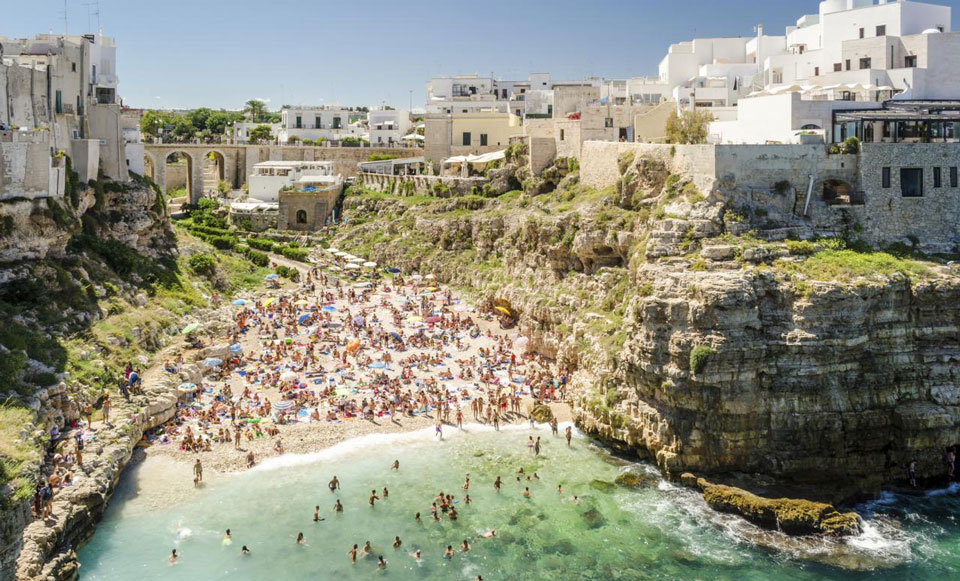If you’ve ever been pick pocketed in Barcelona, duped in Dubrovnik, or scalped in Segovia you’ll know some places rip you off subtly.
However, one famous Italian clifftop village, Polignano a Mare, has thrown out the discretion manual, and decided to implement a “cover charge” for holidaymakers to enter its historic centre.
Polignano a Mare, once a quiet town in the south of Italy, is now a bucket list checkpoint for innumerable tourists seeking the perfect gelato selfie (and cliff diving profile pic).
Although it’s not as famous as Venice, Rome or Florence, the town has caused controversy by following the big city approach to “milking tourists for all they are worth.”
The only difference is, in Polignano a Mare, the policy actually works.
You see, in urban metropoli, such a system is quite tricky to implement (Venice, for instance has a far greater problem with mass tourism, and was only this year able to install turnstiles—without charging for entry).
But as Polignano a Mare is perched atop a series of cliffs, it’s easy for the authorities to control access.
View this post on Instagram
As reported by Traveller, “Tourists have to pay €5 (AU$7.77) to enter the cobbled heart of Polignano a Mare, a spectacularly sited village of whitewashed houses and churches perched on top of vertical cliffs in the southern region of Puglia.”
Predictably, critics reject the new scheme, saying public spaces should not be commercialised, and should be available to everyone.
However, considering the damage tourists are doing elsewhere, the Mayor of Polignano a Mare feels justified in his installation of turnstiles, which are located at the entrances to the village.
Whether Polignano’s picturesque piazzas, winding streets and panoramic terraces (which date back to a Greek settlement of the fourth century BC) and cliff diving (which does not date back to the fourth century BC…) will remain a popular attraction remains to be seen.
But if the numerous Instagram posts of pasta-happy tourists that have appeared in the week since the policy was implemented are anything to go by, the initial signs are positive.
The ticketing system started this month and will cover the whole Christmas season until January 6, a period in which the village is lit up (festive style, not MMA style) by thousands of twinkling lights.
While this is obviously a revenue raising ploy, that didn’t stop Mayor Domenico Vitto pointing out that you should be grateful for your ticket, as it doesn’t just grant you entry to the town, but also diabetes in a bag (popcorn, a doughnut, candy floss and a drink).
“The aim is to attract tourists even during the winter months,” he told The Telegraph. “We have big numbers of visitors during the summer but then it dwindles to almost nothing by October and the town is dead. We want to make it less seasonally dependent.”
This explains the fairy lights, but not the low-season fee.
Whatever the case, some locals, as well as heritage groups, have taken issue with both, saying the ticketing system sets a dangerous precedent which risks turning a popular destination into a Disney-style attraction.
View this post on Instagram
While your author questions equating Christmas lights with Disneyland’s scariest rides, he agrees with the basic premise of keeping public spaces public.
“Installing turnstiles and charging people to enter one of the most famous historic villages in Italy is detrimental to what should be a public place,” a local business association, Confesercenti Terra di Bari, said in a statement.
“Turning the town into a sort of show business, as if it was a fun park for private use, is not a good idea. The town should be part of the cultural heritage of the whole world.”
According to Traveller, “A heritage group, the Italian Environmental Fund or FAI, is thinking of challenging the ticketing system in court.”
But on the flipside, one could argue it is necessary to charge tourists in order to maintain the town as a place that will attract them.
Decisions, decisions…
